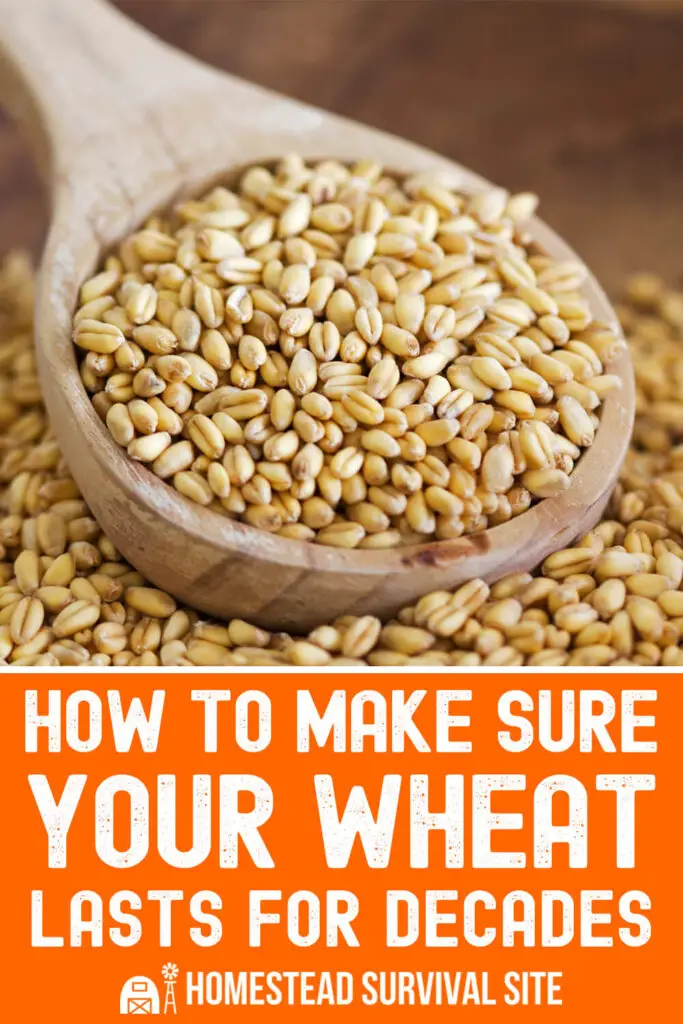Estimated reading time: 6 minutes

If you're looking for a versatile, nutritious food that stores well for decades, you should definitely consider wheat. Not only is it perfect for grinding into flour or eating as a breakfast cereal, but you can also serve it like rice or add it to soups and salads. Wheat is rich in fiber, protein, minerals, and vitamins.
However, proper storage is essential for the powerhouse grain. This article explores how to store wheat berries so they last for several decades. A wheat berry is the term for the wheat kernel, which includes the bran, germ, and endosperm but not the husk.
How to select wheat for long-term storage
First of all, not all wheat is the same, so you need to learn about the three main varieties.
- Hard red wheat. Hard red wheat is rich in protein and gluten, making it an excellent choice for baking rich-tasting, hearty bread and other baked goods.
- Soft white wheat. Soft white wheat has a softer texture and milder taste than hard red wheat. You can use it to make lighter baked goods, including cookies, pastries, and pancakes.
- Hard white wheat. If you only want to store one wheat variety, hard white might be a good option. It has a milder taste and softer texture than hard red wheat, but it still has enough texture for bread.
Look for high-quality whole-grain wheat for your emergency food supply. Consider local farmers' markets, co-ops, bulk foods stores, and online providers. As with many pantry items, you may get the best deals by buying in bulk.
Your wheat should be dust-free, pest-free, and completely dry. Damp wheat can spoil quickly.
How to store wheat long-term
The biggest enemies of your stored wheat supply are moisture, light, oxygen, and pests. Therefore, proper storage is the key to success. The supplies you'll need are food-grade buckets with lids, Mylar bags, and oxygen absorbers.
Food-grade five-gallon buckets (like these) keep your wheat dry, pest-free, and safe from sunlight. When you place Mylar bags inside the buckets, you provide another layer of protection. Additionally, you can remove individual bags as needed without disturbing the rest of your supply.
Placing an oxygen absorber inside each bag is another way to keep your wheat supply safe.
After sealing the Mylar bags, secure the lid on the bucket. You can stack your buckets on top of each other, but as an added safeguard against dampness, avoid placing the bottom bucket directly on the floor.
You can also store your wheat berries in vacuum-sealed glass jars or canisters if you prefer.
Select a cool, dry location for your stored wheat. Aim for a temperature in the 40- to 60-degree Fahrenheit range.
How long will wheat last in your emergency pantry? The answer is 30 years or more when the grain is stored properly!
Ways to use wheat as an emergency food supply
Ground wheat. You can grind wheat to make a nutritious fresh flour for baking bread and other goods and for thickening sauces and gravies. Electric grinders like this one are easy and efficient, but you'll want to add a manual grinder like this one to your supplies so you can grind the wheat by hand in the event of a power outage.
Cracked wheat. Another option is to grind wheat more coarsely to make a breakfast cereal. Then, you can cook it in the same way you do oats for oatmeal.
Whole wheat. When you boil wheat berries in water or broth, you can serve it as a side dish in the same way you would rice. It has a chewy texture and a pleasantly nutty taste. Here's a wheat berry risotto recipe.
Wheat takes on the taste of whatever it's cooked in, so you can add nutritional value to soups and stews. By itself, cooked wheat has little flavor, so it's a perfect add-in to fresh salads and vegetable dishes as well.
Here's how to make breakfast cereal with wheat berries.
- Soak wheat berries overnight and rinse them well in the morning.
- Add three cups of water to one cup of wheat berries and bring the mixture to a boil. Simmer for one hour.
- Add honey, milk, and dried fruit to taste.
If you aren't able to soak the wheat berries overnight, here's a quicker option.
Place wheat berries a half-cup at a time in your blender or food processor. Place the pulse setting a few times. Rinse the pulsed berries and place them in a pot. Add three cups water and simmer the mixture for an hour. Then, add honey, milk, and fruit as desired.
Sprouting your wheat berries
You can sprout some of your wheat berries for more nutritional options. Sprouting reduces the gluten content considerably and increases the nutritional content, including vitamin C.
Here are the steps to follow:
- Rinse a half-cup of wheat berries, removing any debris as you go.
- Place rinsed wheat berries in a quart-size glass jar or other container.
- Fill the jar with water and then cover it with a mesh lid.
- Let the wheat berries overnight or for at least six hours.
- Drain the water off the wheat berries by inverting the jar over a bowl at an angle so air can still circulate while the water runs off.
- Allow the draining process to continue overnight or for eight to 12 hours.
- Rinse and drain again.
- Repeat rinsing and draining twice daily.
You should see tiny sprouts emerging after three days. The process is then complete. Drain well one more time before using or storing the sprouts. Check out this video for tips on sprouting wheat berries.
And here are a few more helpful resources on storing and using wheat berries.
- The Wheat Berry Explained
- How to Cook Wheat Berries
- Meet This Grain: Wheat Berries
- Ancient Grains for Modern Meals
The post How to Make Sure Your Wheat Lasts for Decades appeared first on Homestead Survival Site.
from Homestead Survival Site https://ift.tt/vZSm4hW

No comments:
Post a Comment